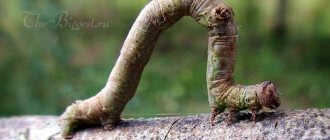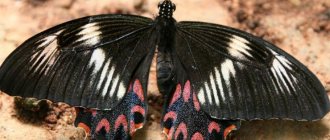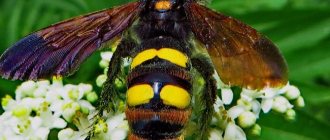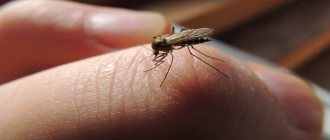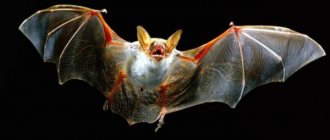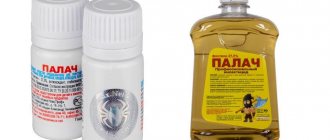Many will agree that butterflies are the most beautiful creatures on the planet. Their larvae - caterpillars - are not inferior to them. Most of them acquired a variegated color to protect themselves from enemies, and many species produce poison for protection. But the most poisonous caterpillars in the world are not always brightly colored. They often skillfully disguise themselves as their environment. We go to gardens and forests to get closer to the beautiful but dangerous butterfly larvae.
The most poisonous caterpillars on the planet:
1
Coquette / Megalopyge opercularis
When you see such a creature in nature, you might not immediately guess that it is a caterpillar. The larva, covered with a kind of fur, looks more like a furry animal. This is the larva of the flannel moth, native to the southern states of the United States.
But it is not recommended to iron it. Under its hairs are poisonous spines that release a toxic substance when touched. The touch is quite painful, and after about five minutes redness may appear.
This feature is necessary for protection. Attentive nature lovers have noticed that the hairy caterpillar bears a striking resemblance to Donald Trump's hair.
2
Saddle Caterpillar / Sibine stimulea
The larva of a gray butterfly from the slug family has a rather menacing appearance. On the green body there are brown spots along the edges, and in the middle there is a spot with a white border, resembling a saddle in shape.
They grow up to 3 cm during the development period. At both ends of the body there are two pairs of horns covered with hairs. At the tips of the hairs there are glands that produce a toxic substance.
The touch causes pain, which is comparable in strength to a bee sting. A rash appears at the site of contact, accompanied by headache and nausea. This rash will last for two days. It defends itself with its poisonous horns, and itself eats many types of plants.
3
Features of poisonous caterpillars
The main distinguishing feature of poisonous caterpillars is the presence of toxic substances in their body. The poison is found on the tips of the spines, spine-like processes, hairs or villi covering the insect's body.
The main external sign of toxicity of the larvae is its variegated color.
Many types of caterpillars blend into their surroundings like chameleons, but poisonous species are almost always painted in bright and catchy colors.
Parasa indetermina
The larva of the Parasa indetermina butterfly, due to its unusual appearance and ability to burn, received the nickname “Burning Rose”. It grows no more than 2.5 cm, and its range is limited to the North American continent.
She has bright colors and various stripes can be seen on her body. Red and yellow spots. In addition, for protection, it has a number of processes on which there are burning tubercles. When touched, the tips of these tubercles break off, and severe pain and irritation are felt at the point of contact.
It feeds on the leaves of fruit trees, especially often affecting various varieties of apple trees. Also found in deciduous forests.
By the way, on our website most-beauty.ru there is an interesting article about the most beautiful butterflies in the world.
4
Spiny oak slug caterpillar / Euclea delphinii
Experts note that the larva of this species of butterfly is not too dangerous, but during its evolution it has also developed protective mechanisms. They reach a length of no more than 1.5 cm, and feed, if you look at the species name of the butterfly, on oak leaves.
The body color is quite variegated. Throughout the body there are small outgrowths, at the tips of which a special substance is concentrated. Once in contact with the skin, this mucus causes a rash. These shoots are spiny. Touching them is quite painful. The touch is quite painful.
In addition to oak trees, such lumpy creatures can be found on willows and maples. She loves to eat both the leaves and fruits of garden trees, thereby harming agriculture.
5
Volyanka / Orgyia leucostigma
Small butterflies have settled on all continents, and in total there are more than 2,700 species. Particularly large populations are found in the tropical and subtropical zones of Southeast Asia and the African continent.
The caterpillars of many species of mothwort are poisonous. There are hairs on the body that contain a toxic substance. During periods of mass reproduction, such larvae can cause great harm to animals and humans. The poison causes inflammation of the respiratory tract, affects the mucous membrane of the eyes and causes a rash on the skin.
In addition, they are polyphagous and cause great harm to garden crops. They develop both on trees and on shrubs and herbaceous plants.
6
Common Dipper / Tyria jacobaeae
This species acquires toxicity as a result of eating a poisonous plant - Jacobea vulgaris. The ability to eat plantings of a poisonous plant is widely used by farmers in Australia and New Zealand to destroy a dangerous weed.
Because of the red coloring of her body, she is also called the Bloody Bear. The caterpillar eats the plant and becomes poisonous itself. They are not dangerous to humans, but pose a threat to birds that eat them.
A small number of these butterflies, and, consequently, caterpillars, were discovered in the Mozhaisk district of the Moscow region. Over the past 40 years, there has been a decline in the number of this butterfly species, which is why many states have adopted laws to protect the species.
By the way, on our website most-beauty.ru there is a fascinating article about the most poisonous and dangerous insects in Australia.
7
How to detect harmful insects
It turns out that you don't have to wait until your plants are completely empty to detect the presence of caterpillars. Inspect the green spaces and check if they have:
- Eggs. The best way to distinguish caterpillar eggs from other insect eggs is to watch the butterfly crawling on its host plant. As it moves through its host plant, look for the tiny specks it leaves behind. The butterfly lays them singly or in groups, and the color varies from white to yellow, green or brown.
- Holes in leaves. Pests usually leave holes in the middle of the foliage, but the caterpillars start at the edge of the leaf and move inward. Look for ragged or jagged leaf edges.
- France This is a fancy term for a caterpillar's "poop." France caterpillars look like scattered ground black pepper on the foliage, which pests actively feed on.
Redtail / Calliteara pudibunda
The distribution area of this butterfly is quite wide, but is divided into two large regions. The first, these are the countries of Western Europe, is found in Belarus and Crimea.
The second is the eastern regions of Russia. Widely settled in Siberia and Primorye. It is also called Shy Paw. The entire body of the caterpillar is covered with hairs, and the color is quite varied. There are red, pink, as well as brown and gray individuals. But they all have a small red ponytail at the back.
Touching human skin causes an allergic rash and redness. A furry caterpillar will not do much harm, but it will be unpleasant.
8
Purple Hawkmoth / Mimas tiliae
The small caterpillar reaches an average length of no more than 6 cm at the peak of development. The species of this inconspicuous butterfly was discovered by Carl Linnaeus in 1758.
The body is rough, and there is a horn on the tail. This horny process has a protective shield. Development begins in early summer. During this period, they can be found on the branches of wild and fruit trees. There are especially many of them on linden, birch, and various types of alder. By the time of pupation, the body color completely changes.
It is not dangerous in itself, but if it crawls across the body, it will leave a bright mark. There are substances on her body that cause an allergic reaction. It is most difficult for allergy sufferers and people with weakened immune systems.
9
Saturnia io / Automeris io
The beautiful peacock butterfly is found in Canada and the United States. The entire body of the caterpillar of this butterfly is covered with peculiar greenish thorny pom-poms.
She herself is light, and does not grow more than 4–5 cm. You can only admire this view from afar, but under no circumstances pick it up or even touch it. After contact with the thorns, poison penetrates the body. Toxic substances cause redness, pain at the injection site and can even cause the development of dermatitis.
It looks like a very cute and safe creature. But this is yet another proof that beauty is deceptive.
10
Description of the caterpillar Lonomia
Name: Lonomia Lat.: Lonomia
Class: Insects - Insecta Order: Lepidoptera - Lepidoptera Family: Peacock-eyes - Saturniidae
| Habitats: | tropics and subtropics |
| Dangerous for: | people and animals |
| Peculiarities: | the most dangerous genus of caterpillars |
Lonomy caterpillar.
The most dangerous caterpillars are representatives of the genus Lonomy. They have a deadly venom on their spines - a strong, natural toxin. The brownish-green color helps to camouflage. Sometimes they merge with the bark of trees.
Brighter individuals can also remain unnoticed, because they find the most inconspicuous place for themselves. Color ranges from beige to light orange and pink. The structure is identical to fleecy fabric or plush.
Later it becomes a harmless butterfly belonging to the peacock-eye family. The wings are usually open. Length ranges from 4.5 to 7 cm.
Lonomy.
Witch moth / Phobetron pithecium
The most peculiar and unusual caterpillar in wildlife usually lives on fruit trees in orchards. Because of its unusual appearance, it is also called the “slug monkey.”
The entire body is covered with thick hair, and the body structure differs from the usual physique of butterfly larvae. Most often, the hair is light brown in color, which darkens with age.
Nature took care of protection, because not every bird will decide to peck such a “monster”. This type of larva can be perceived in different ways, but the hairs contain a toxic substance. If it comes into contact with the skin, it causes redness that goes away after a few days.
Skin itching and rash from the burning hairs of silkworm caterpillars
The caterpillar of the traveling oak silkworm, as is obvious from the name, lives on oak trees. The walking pine silkworm lives on pine trees and feeds on pine needles. If the area where you live is rich in oak forests, pine plantations, or such trees grow in your garden plot, the likelihood of silkworm caterpillars appearing is quite obvious and the possibility of infection is very high.
For example, skin itching, redness and rash are symptoms that you can get when interacting (biting) with this hairy pest. The reaction to a hair burn manifests itself differently in everyone. However, the itching can sometimes be unbearably strong, and the skin is irritated. The surface of the skin becomes uneven, covered in rashes and blisters, and the most unpleasant thing is that the more you scratch the inflamed skin, the more itching and irritation of the skin increases.
Hickory Dipper / Lophocampa caryae
Another fluffy, dangerous caterpillar that lives in North and Central America. The white fluffy creature looks completely harmless.
It does not have poison, but the hairs have barbs that can damage the skin. Inflammation is observed in the damaged areas. The area becomes itchy and later develops an unpleasant rash. One of the few that can bite.
It grows no more than 3 cm. Development occurs in late spring and early summer. People with allergies should especially stay away from them.
12
The most common caterpillars
Caterpillars are the larvae of butterflies and moths. They damage plants by chewing leaves, flowers, shoots, fruits, and sometimes by drilling into wood. Caterpillars have three pairs of legs directly behind the head and leg-like appendages on some but not all abdominal segments, distinguishing them from beetle and fly larvae.
Caterpillars are very easy to recognize and distinguish from other insects: they have a soft body that is shaped like a worm.
There are several butterfly caterpillars that feed on garden crops and other plants:
The most common caterpillars are hawthorns , which live on the leaves of trees entwined with cobwebs.
Caterpillar of a cabbage butterfly (cabbage white butterfly) living on white cabbage. It feeds on leaves, which are then full of holes. Moreover, the larvae can move deeper into the head of cabbage and settle there firmly.
Cabbage cutworm , in addition to cabbage itself, can feed on the leaves of potatoes, tomatoes, beets and other garden crops. Often found in areas with high humidity.
Leaf rollers are also dangerous for plants - these are small caterpillars that destroy buds, leaves and inflorescences. Leaves twisted into a tube with a web inside are an indicator of the presence of a leaf roller. It multiplies quickly, so you need to act immediately.
swallowtail caterpillar looks no less bright and attractive than the butterfly itself: green, with black transverse stripes and orange splashes. The pest is very voracious, feeding mainly on Umbelliferae (carrots, parsley, dill, etc.).
may be a gypsy moth . This species is able to quickly settle throughout the entire area due to the fact that it moves with the wind.
If you notice that your onion leaves are being eaten away from the inside, the onion moth is most likely doing it . Over time, translucent, gradually yellowing spots may appear on the damaged areas. The caterpillar is light green in color and feeds on bulbous crops (shallots, leeks, onions, etc.).
Experienced gardeners advise identifying the type of caterpillars that have attacked the garden. This will help you choose a method for removing them more effectively. However, we should not forget about prevention.
Saturnia Maya / Hemileuca maia
In the photo you can see what the caterpillar of a beautiful butterfly looks like. But the larva disgusts her and discourages her from getting to know each other better.
The entire body is covered with hollow spines, which are connected to poisonous reservoirs. When examined under a microscope, you can see that these spines are covered with multiple hairs. They themselves are dark, but the caterpillar's body is light.
The poison causes severe itching and burning in the victim. After the initial external symptoms, headache and nausea begin. From spring to mid-summer they sit in large groups on oak branches and willows.
13
Caterpillars that can kill
What does a coquette caterpillar look like?
like a miniature furry animal. However, as soon as you touch it, an unpleasant surprise awaits you. Poisonous spines hidden under its “fur” release poison, causing severe throbbing pain that can radiate to the armpit, five minutes after contact with the caterpillar. Red erymatous spots may appear at the site of contact. Other symptoms include: headache, nausea, vomiting, abdominal discomfort, lymph node involvement, and sometimes shock or difficulty breathing.
The pain usually subsides after an hour, and the spots disappear after a few days. However, if a large amount of poison is ingested, symptoms can last up to 5 days.
2. Saddle caterpillar (Sibine stimulea)
The hoary caterpillar attracts attention with its bright colors, and believe me, you better stay away from it. Its fleshy horns are covered with hairs that secrete poison.
Touching them will cause pain similar to a bee sting, swelling, nausea and a rash that will last for several days.
3. Stinging rose caterpillar (Parasa indetermina)
The “stinging rose” caterpillar reaches a length of only 2.5 cm and is distinguished by its bright colors. But besides its yellow and red spots, what attracts the most attention are its spiny tubercles protruding from different sides.
The tips on these tubercles, as one might guess, release poison. If you touch one of them, the ends will break off and you will experience skin irritation.
4. Spiny oak slug caterpillar (Euclea delphinii)
This caterpillar is not as dangerous to humans, although touching it will still cause a rash. This is due to the spiny tubercles located on the back and sides.
As a rule, these caterpillars live on oaks, willows, as well as beech, cherry, maple and other deciduous trees.
5. Caterpillar of the black bear (Tyria jacobaeae)
Some caterpillars become toxic through the plants they eat. And this applies to the caterpillars of the mole bear, which feed on poisonous ragwort.
They eat so much of this plant that in New Zealand, Australia and North America they are used to control the growth of ragwort. This plant is fatal to cattle and horses and poses some health hazard to humans.
If you are susceptible to caterpillar hairs, touching them can cause hives, atopic asthma, kidney failure and cerebral hemorrhage.
6. Caterpillars of the marching silkworm (Thaumetopoea pityocampa)
Traveling silkworm caterpillars live in groups in large silken nests high on pine trees.
They follow each other from the nest to the pine needles in search of food. And as you may have guessed, contact with them is dangerous. They are covered with thousands of tiny harpoon-shaped hairs, the touch of which causes severe skin irritation.
7. Bag caterpillar (Ochrogaster lunifer)
Just like the caterpillars of the traveling silkworm, these representatives live in groups in a silk bag, emerging at night and following each other in search of food. However, the danger from them is greater.
In South America they pose a health risk. The venom contained in their bristles is a powerful anticoagulant. This means that if you accidentally touch them, you risk bleeding from a small cut or internal bleeding.
8. Saturnia io caterpillar (Automeris io)
This caterpillar is native to Canada and the United States, and although it looks like an adorable little thing with green spiked pom-poms, remember that they are for viewing only.
No matter how tiny their spines may seem, the poison they contain can cause painful itching and even dermatitis.
9. Witch moth caterpillar (Phobetron pithecium)
If you thought the coquette caterpillar looked rather unusual, admire this furry creature. The witch moth caterpillar, also called the slug monkey, is often found in orchards.
People vary in their susceptibility to these caterpillars, and for some they cause unpleasant symptoms, including itching and rashes.
10. Hickory Bear Caterpillar (Lophocampa caryae)
It seems as if these caterpillars are dressed in winter fur coats. Most of the hairs covering their body are fairly harmless, but they do have four long black hairs on the front and back that should be avoided.
Touching them leads to a rash and more serious health problems if the hairs get into the eyes. Plus, they still bite.
11. Lazy clown caterpillar (Lonomia obliqua)
This peacock butterfly caterpillar can safely be called a killer caterpillar. Its thorns are filled with poison, a coagulant - an anti-clotting substance, which can lead to the death of a person.
Light touching of these caterpillars can lead to headache, fever, vomiting and, if untreated, internal bleeding, kidney failure and hemolysis.
Their venom is so powerful that scientists are studying it in hopes of developing a drug that prevents blood clots.
12. White cedar moth caterpillar (leptocneria reducta)
This caterpillar already inspires fear with its appearance. The hairs of this tiny crawling "cactus" can cause an allergic itching reaction in some people.
In addition, the caterpillars themselves live in large groups, swarming on a tree at the same time, eating every single leaf before moving on.
13. Saturnia Maya caterpillar (Hemileuca maia)
One look at this caterpillar should discourage you from touching it. It is covered with hollow spines attached to a venom sac, and touching it will not only cause itching and burning, but will also lead to nausea.
They live mainly on oaks and willows from spring to mid-summer.
14. Caterpillar (Orgyia leucostigma)
This caterpillar is easy to spot because of its red head, black back, and yellow stripes on its sides. In addition to the fact that this caterpillar stings unpleasantly, it is considered a pest of trees, eating everything woody in its path.
But try to remove it from the power source, and you will be in trouble.
Lonomia / Lonomia Obliqua
One of the most poisonous caterpillars on the planet is the larva of the Peacock butterfly, found in Latin America. Reaches a length of 5.5 to 8 cm. The entire body is covered with fine hairs. They are also called the Lazy Clown.
Numerous studies have proven that lomonia can produce toxic substances dangerous to human life and health. For the first time, attention was paid to toxin poisoning in 1983, when dangerous creatures caused a massive epidemic in the Brazilian state of Rio Grande do Sul.
A poisonous caterpillar from South America has caused the death of many people. Fatal outcomes after encountering it are recorded especially often in the south of Brazil.
14
Pine silkworm / Thaumetopoea pinivor
In Russia, poisonous caterpillars are not as dangerous as those in South America, but they can also cause a lot of trouble. This type of silkworm received its name due to the massive migrations of larvae. They live on pine needles, which they feed on.
During development, lush hair appears on the body. Adult individuals break these hairs themselves, resulting in the formation of a kind of dust. When such dust gets on the mucous areas and skin of a person, a strong burning sensation begins.
Then the skin turns red and severe itching begins. Symptoms appear within a few weeks. After contact, you should seek medical help.
15
Folk remedies for insects
If there are a lot of pests, you can easily be left without a harvest. Therefore, it is important to deal with them in time and do it correctly. Here are some effective folk remedies for caterpillars:
- Infusion of field chamomile – 1 liter. water accounts for 100 g of crushed chamomile. Leave it in a dark place to brew. Then filter and add water 1:5. You can add any additional adhesive.
- Infusion of black henbane - 10 liters. take 1 kg of water. chopped henbane. Allow to stand for about 12 hours and the solution is ready for spraying.
- Tobacco decoction - 200 g of tobacco or shag, pour 3 liters. water. Leave to stand for a day. Then boil the solution for several hours. Strain and add 10 l. water. Use immediately after production.
- Infusion of spotted hemlock - crushed raw materials are ground into a paste. 1 kg. This slurry is diluted with 2 liters. water. Let it sit for a while, drain and pour back 15 liters. water. After 10 hours, drain the liquid and add it to the 2 liters that were drained earlier. Use only for young caterpillars.
- Red pepper decoction - 10 liters. add 1 kg of water. red pepper. Everything boils for about an hour. Leave to infuse for a day. You can store the decoction in the refrigerator. Dilute 12 grams. infusion for 10 l. liquids.
- Peppermint infusion – 2 kg. pour 10 liters of chopped grass stems. water and let it brew for about a day. The solution is ready.
- Red elderberry decoction - 200 g of crushed flowers and branches, pour 10 liters. water. Bring to a boil, let cool and can be used before and after flowering.
- A decoction of tomato tops - fill a bucket with dried tomato tops almost to the top, add water and put on fire. Boil well for 1 hour. After diluting it 2:10, you can add soap.
- Fumigating trees - add 1 part resin and 2 parts sulfur to a container with hot coals. To fumigate a tree, if possible, you can hang the container between the trees on the branches.
Folk remedies are not always as effective and efficient as store-bought insecticides. But they are also capable of causing significant damage to the multi-legged plant pest.
Thus, caterpillars are dangerous insect pests, and far from being friends in our garden plots. They can destroy crops or green spaces in a matter of days, so you need to regularly take preventive measures, and when these insects appear, deal with them immediately.
Ochrogaster lunifer
This type of caterpillar is called "hiding in a bag." They stay in groups in a silk bag during the day, and at night they crawl out to hunt, moving one after another.
The species lives in South America and poses a danger to humans. The black caterpillar is completely covered with sharp hairs. They are not poisonous, but touching them can cause a deep cut.
The whole danger is that these hairs act as a powerful anticoagulant. This substance slows down the process of blood clotting. To avoid big problems, it is necessary to provide medical assistance.
The most dangerous butterfly caterpillars
Many butterflies are harmless in their adult stages, but their caterpillars can cause serious harm. The toxicity of the substance secreted by the body allows them to protect themselves from birds and some animals.
Lonomiya
Contact with this insect poses a serious danger to humans. It is not for nothing that Lonomy is called the most poisonous caterpillar on its continent. The toxin released by the body can cause a real epidemic of deaths.
Attention! Not only adult lonomia are able to camouflage themselves in the surrounding nature. The caterpillar can often be confused with moss that grows on trees.
Caterpillar Lonomiya
Megalopys opercularis
In America, poisonous caterpillars of this species are called coquettes. Outwardly, they look like a fur ball that you want to pet. But hidden under the villi are poisonous spines that easily penetrate the skin upon contact.
The injection immediately causes severe pain, and the puncture site swells and turns red. Other symptoms also appear:
- nausea, sometimes with vomiting;
- discomfort in the stomach;
- headache;
- rapid breathing.
In most cases, the toxin is eliminated from the body within a day, and with it the negative symptoms go away. But the development of anaphylactic shock with severe complications is possible.
Megalopys opercularis
Hickory bear
These fluffy larvae do not emit poison, but are still considered dangerous caterpillars. It's all about the microscopic notches located on the bristles. When they come into contact, they cling to the skin, causing itching and a rash.
Important! Jagged edges can get into your eyes from your hands, and can only be removed through surgery.
Hickory bear
Goldentail
This butterfly can be encountered both on the American continent and in Europe. It also lives in Russian latitudes (forests, gardens, park areas). It is easy to recognize a small insect by its white wings, which barely reach 4 cm in span.
You don't have to be afraid of contact with these butterflies - they are not poisonous. But their caterpillars are one of the most dangerous. Touching their hairs causes the skin to break out in a rash and scars may appear. People prone to allergies have difficulty breathing.
Goldentail Caterpillar
Caterpillar Monkey
This witch moth larva cannot be called a caterpillar in the usual sense - its appearance is so unique. The individual does not have legs - lying flat on the surface, it is held there by suction cups.
Until recently, the caterpillar was considered poisonous, but there is no toxin in its body. Although it remains dangerous for allergy sufferers, causing skin rashes and itching upon contact.
Caterpillar Monkey
Saturnia io
The bright red larvae, which later turn green, are equipped with poisonous bristles. They are so toxic that, in addition to pain, swelling and itching, they can cause dermatitis and even necrosis of the integument. Sometimes close contact with the caterpillar leads to the death of cells in the inner layers of the dermis.
Saturnia io
Redtail
The larvae got their name due to the bright villi that stick out in a tuft at the back of the body. The color of the body itself can vary from pale gray to deep brown. It all depends on the habitat to which you have to adapt.
In domestic latitudes, the insect is found everywhere except the Far North. These Russian caterpillars are considered conditionally poisonous - an allergic reaction from contact is manifested by redness, itching and rash.
Redtail
Traveling silkworm
These larvae love to move from place to place. They travel in groups - clinging to each other, forming a small living “train”. Most often, such processions are observed in the spring in Mediterranean countries.
Traveling silkworm
The danger of meeting a silkworm is that you don’t even have to touch the insect to develop similar symptoms:
- blisters on the skin;
- hives;
- severe itching.
Hairs from the larva's body can fall off accidentally, and not just when touched. This process is accompanied by the release of a toxic liquid, droplets of which spread through the air over long distances.
Contact of poison on the skin, respiratory tract and mucous membranes causes shortness of breath, development of pharyngitis, rhinitis, conjunctivitis.
In Italy, silkworm caterpillars are called pet killers. It is enough for an animal to lick a string of traveling larvae to receive a lethal dose of poison.
Baang haang
This is the name of the caterpillars of Thailand. We will complete our list of most-beauty with them. Almost all caterpillars of an exotic country will cause a lot of problems for tourists. After meeting them, the body itches for weeks and a rash appears.
Like many inhabitants of tropical forests, the larvae of Thai butterflies are beautiful and distinctive. Most species are brightly colored to scare off enemies. Some, on the contrary, disguise themselves as foliage or the earth's surface.
When going to any country, you need to study what dangerous creatures you can encounter in its open spaces.

